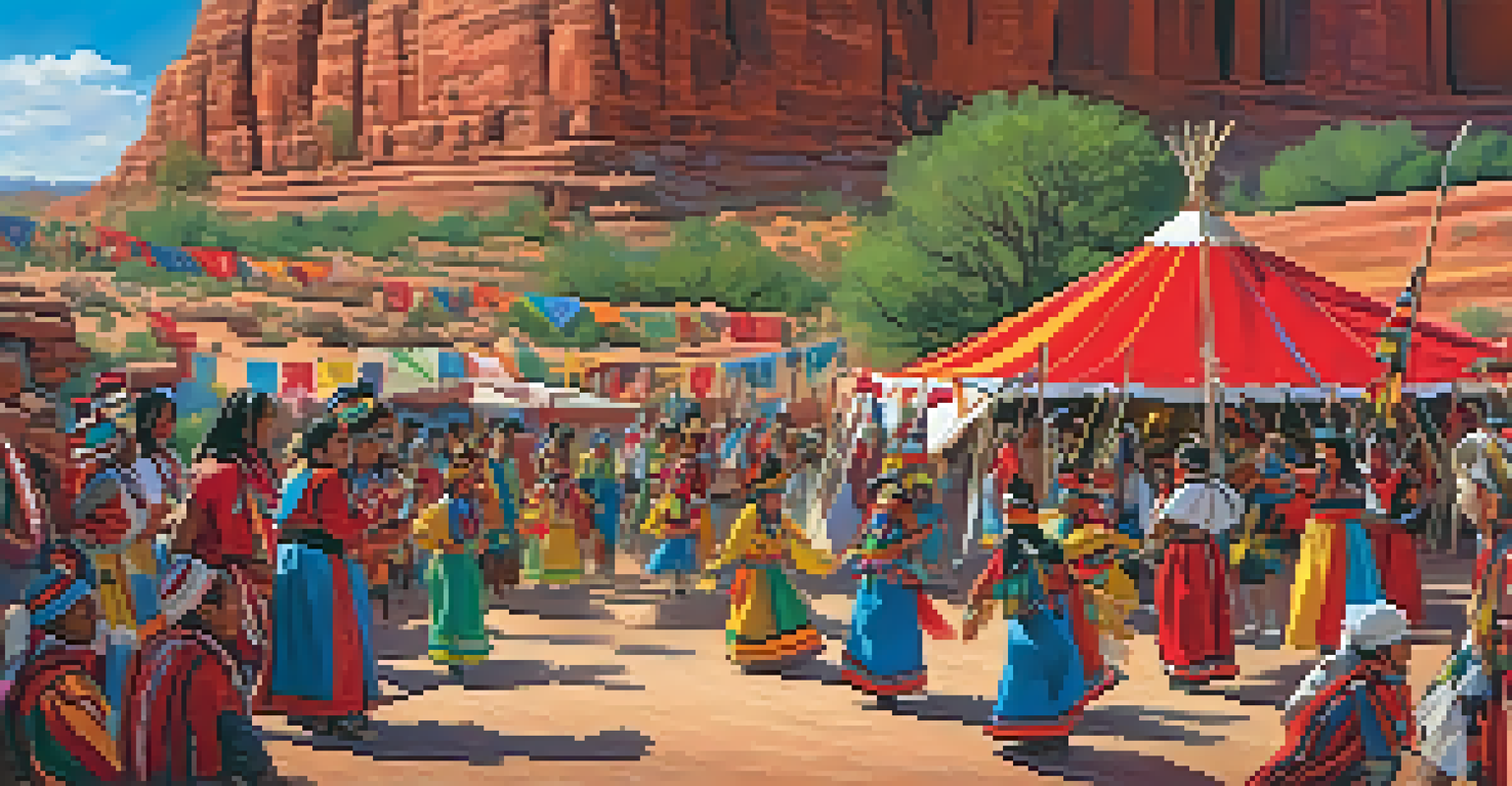Hopi Nation: Their Legacy and Influence in Sedona

Understanding the Hopi Nation's Rich Heritage
The Hopi Nation, a Native American tribe located in northeastern Arizona, is known for its deep cultural heritage and spiritual traditions. With a history that dates back over a thousand years, the Hopi people have maintained a unique way of life that emphasizes harmony with nature and community living. Their ancestral lands are dotted with ancient pueblos, which showcase their architectural skills and connection to the earth.
We do not inherit the earth from our ancestors, we borrow it from our children.
Traditionally, the Hopi people are known for their agricultural practices, particularly corn farming, which holds significant spiritual importance. They have cultivated various corn varieties, each representing different aspects of their culture and spirituality. This connection to agriculture is still evident today, as many Hopi actively engage in farming as a way to preserve their traditions.
The Hopi's storytelling and art are also integral to their heritage, with intricate pottery, weaving, and traditional dances that reflect their beliefs and customs. These art forms not only serve as a means of cultural expression but also play a vital role in educating younger generations about their identity and history.
The Spiritual Significance of Sedona
Sedona, Arizona, is renowned for its stunning red rock formations and vibrant energy, making it a popular destination for spiritual seekers. The Hopi Nation has long considered this area sacred, believing that its natural beauty is intertwined with their cultural legacy. The red rocks are not just picturesque; they hold spiritual significance, serving as places for prayer and reflection.

The concept of 'spiritual vortices' in Sedona adds another layer to its significance. Many believe these vortices are centers of energy that can enhance meditation and healing. The Hopi, with their strong spiritual connections to the land, have contributed to the understanding of these energy centers, fostering a greater appreciation for the natural world.
Hopi Heritage and Spirituality
The Hopi Nation's rich cultural heritage emphasizes harmony with nature and community, deeply rooted in their agricultural practices and spiritual beliefs.
As visitors come to Sedona seeking spiritual renewal, the Hopi's teachings about respect for the earth and communal harmony resonate deeply. They encourage people to connect with nature, reminding us that we are all part of a larger ecosystem that deserves care and reverence.
Hopi Influence on Sedona's Arts and Culture
The artistic influence of the Hopi Nation can be seen throughout Sedona, where their traditional crafts and contemporary art thrive. Local galleries often showcase Hopi pottery, kachina dolls, and jewelry, reflecting the tribe's rich artistic heritage. This visibility not only supports Hopi artists but also educates visitors about their culture and traditions.
The land is the source of all life, and we are a part of it.
Moreover, many artists in Sedona draw inspiration from Hopi designs and motifs, blending them with their own styles. This fusion creates a unique cultural tapestry that highlights the importance of cross-cultural collaboration while respecting the origins of the art. It’s a beautiful example of how cultures can influence one another while maintaining their distinct identities.
Events like art fairs and cultural festivals further promote Hopi arts, inviting community members and visitors to engage with Hopi traditions. These gatherings provide a platform for storytelling, dance, and music, allowing the Hopi to share their heritage and wisdom with a broader audience.
Educational Initiatives and Cultural Preservation
Education plays a crucial role in the preservation of Hopi culture and language. The Hopi Nation actively promotes programs aimed at teaching younger generations about their heritage, ensuring that traditions are passed down. This commitment to education is vital, as it helps maintain their cultural identity in a rapidly changing world.
In Sedona, partnerships with local schools and organizations have emerged to provide workshops and cultural exchanges. These initiatives create opportunities for Hopi elders to share their knowledge and experiences, fostering mutual respect and understanding between cultures. Such programs not only enrich the local community but also empower Hopi youth to embrace their identity.
Impact of Tourism on Hopi Culture
While tourism in Sedona can promote awareness and economic opportunities for the Hopi Nation, it also poses risks of cultural appropriation and misrepresentation.
Additionally, the Hopi Nation has embraced modern technology to spread awareness about their history and culture. Through social media and online resources, they reach a global audience, showcasing their art, traditions, and values. This blend of tradition and innovation is key to keeping their legacy alive in today's digital age.
The Role of Hopi Spirituality in Environmental Stewardship
Hopi spirituality emphasizes a deep respect for the earth, which aligns closely with contemporary environmental movements. Their beliefs teach that humans are caretakers of the land, and this philosophy has significant implications for sustainability efforts in Sedona. By fostering a connection to nature, the Hopi encourage practices that promote ecological balance.
In recent years, the Hopi Nation has been involved in various environmental initiatives, advocating for the preservation of natural resources. Their traditional ecological knowledge, passed down through generations, offers valuable insights into sustainable practices that can benefit both the environment and local communities. This knowledge serves as a bridge between ancient wisdom and modern conservation efforts.
As Sedona faces environmental challenges, the Hopi Nation's teachings remind us of the importance of stewardship. They inspire all of us to consider our impact on the planet and to engage in practices that honor and protect our natural surroundings.
Tourism and Its Impact on the Hopi Nation
Tourism in Sedona has both positive and negative impacts on the Hopi Nation. On one hand, increased visitor interest can lead to greater awareness of Hopi culture and provide economic opportunities for artists and community members. Many Hopi artisans participate in local markets, sharing their crafts and stories with visitors while fostering cultural exchange.
However, tourism can also pose challenges, as it sometimes leads to cultural appropriation and misrepresentation. The Hopi Nation is vigilant about protecting their cultural heritage from exploitation, striving to educate visitors on the importance of respectful engagement. They encourage tourists to learn about their traditions and to support authentic Hopi businesses.
Cultural Preservation Initiatives
The Hopi Nation is committed to preserving their culture through education and modern technology, ensuring future generations remain connected to their heritage.
To navigate these complexities, the Hopi Nation has developed guidelines for respectful tourism, emphasizing the importance of understanding their culture before visiting. By promoting ethical tourism practices, the Hopi aim to create a balance that honors their heritage while allowing for meaningful interactions with visitors.
Looking Ahead: The Future of the Hopi Nation in Sedona
As we look to the future, the Hopi Nation continues to adapt and thrive while holding onto their traditions. Their presence in Sedona is not just a testament to their rich history but also a beacon of resilience and cultural pride. The ongoing dialogue between the Hopi and the Sedona community fosters a spirit of collaboration and mutual respect.
The Hopi Nation's commitment to cultural preservation and education will ensure that future generations remain connected to their heritage. By engaging with both local and global communities, they are creating opportunities for cultural exchange that enrich everyone involved. This ongoing relationship highlights the importance of diversity and inclusion in today’s world.

Ultimately, the legacy and influence of the Hopi Nation in Sedona will continue to evolve, guided by their values of harmony, respect, and community. As they navigate the challenges of the modern world, the Hopi remain dedicated to preserving their traditions and sharing their wisdom with all who seek to learn.